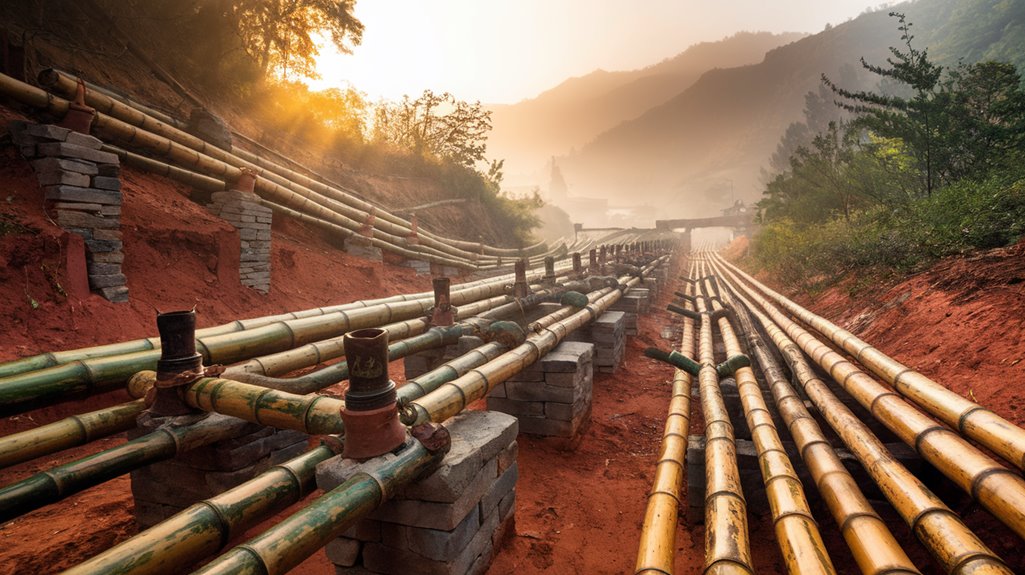Ancient China’s Gas Pipelines: 2,000 Years Ahead of Their Time
When you walk through modern cities with their steel gas pipelines, you'd never guess that Ancient China mastered natural gas transportation using bamboo over 2,000 years ago. In Sichuan Province, Chinese engineers created an extensive network that moved gas from wells to homes and factories, long before Western civilizations understood its potential. This remarkable achievement raises fascinating questions about how such an advanced civilization developed solutions we're still using today in modified forms.
The Discovery of Natural Gas in Ancient Sichuan

While other ancient civilizations merely observed natural gas seeps, the Chinese in Sichuan pioneered its systematic extraction and use as early as the fourth century BCE.
Using ancient technologies like bamboo drilling tools, they developed sophisticated methods to reach underground gas deposits in the Sichuan Basin, an area uniquely rich in both natural gas and brine. The use of bamboo composite pipes proved remarkably effective for transporting and controlling gas flow. Today, this same region continues to yield significant discoveries, with total reserves exceeding 100 billion cubic meters at the Tongnanba field alone.
The Chinese discovered practical gas applications that would transform their industrial capabilities, particularly in salt production.
You'll find that they didn't just stumble upon this resource – they actively sought it out, documented their findings, and developed increasingly complex extraction methods.
Their systematic approach to natural gas exploitation in the Sichuan Basin demonstrated an advanced understanding of resource management that wouldn't be matched in the West for nearly two millennia.
Engineering Marvel: Bamboo Pipeline Networks
The ancient Chinese engineers took their gas discoveries a step further by developing an intricate network of bamboo pipelines – an engineering feat that would revolutionize energy distribution.
You'll be amazed to learn how they mastered bamboo sustainability, using this abundant material to create sturdy pipes that could transport natural gas for hundreds of kilometers.
These ancient engineering marvels weren't just simple tubes; they were carefully constructed with twine bindings and waterproof glue to guarantee airtight connections.
By the 1700s, you'd find extensive pipeline networks throughout Sichuan province, serving approximately 130,000 wells and remaining operational until the 1950s.
The ingenuity of these systems lay in their simplicity and effectiveness, proving so reliable that they continued serving communities for over two millennia, demonstrating remarkable durability and practical design.
The cumulative gas production through these bamboo networks in the Zigong region alone reached an impressive 30 billion cubic meters over their operational lifetime.
Similar to the ancient water pipes of Pingliangtai, these gas networks demonstrated how complex engineering could thrive without centralized authority.
Early Chinese Gas Refining and Safety Methods
Ancient Chinese engineers developed sophisticated refining methods after discovering that raw natural gas required careful processing for safe use.
They realized certain gas deposits couldn't be utilized without proper mixing with air, leading to the development of groundbreaking safety standards and refining techniques.
You'll find it fascinating that they created the world's first carburetor-like system to achieve the perfect gas-air mixture.
Their innovative "Kang Pen" drum, introduced in the 18th century, proved revolutionary in separating gas from brine efficiently.
These early Chinese innovations predated Western developments, as they transported gas through bamboo pipelines thousands of years before European systems emerged.
These advancements weren't just about safety – they greatly boosted production efficiency, particularly in salt manufacturing where natural gas was used to heat brine.
The careful attention to refining processes shows you how advanced their understanding was, even without modern scientific instruments.
Similar to their mastery of iron smelting using blast furnaces, they demonstrated exceptional skill in processing raw materials for industrial use.
Global Impact and Historical Significance
Dating back to 900 BC, China's pioneering natural gas developments have shaped global energy infrastructure and continue to influence modern geopolitics.
You'll find evidence of China's early mastery in the ancient wells of Sichuan, where sophisticated drilling techniques and bamboo pipelines predated Western developments by centuries. The Chinese innovation of using hollow bamboo stalks for transporting gas demonstrated remarkable engineering insight for that era.
Today, China's geopolitical influence extends through massive projects like the Central Asia-China Gas Pipeline, which spans 7,000 kilometers and supplies 20% of China's gas needs.
You're witnessing a historic power shift as China's infrastructure investments create new patterns of energy dependency in Central Asia, effectively replacing Russia's traditional dominance.
This modern expansion mirrors China's ancient leadership in gas technology, from the early use of "Kang Pen" drums to today's continent-spanning pipelines.
Technological Legacy and Modern Comparisons

While modern drilling technologies rely heavily on advanced materials and computerized systems, you can trace many fundamental principles back to China's ingenious bamboo-based drilling methods from over two millennia ago.
The technological influence of these ancient techniques is evident in today's percussive drilling operations, and you'll find that many modern solutions mirror their historical counterparts. By the 3rd century AD, Chinese engineers had achieved remarkable feats, drilling wells to depths of 140 meters.
The cultural implications of China's early mastery of gas extraction and transportation extend beyond mere engineering.











